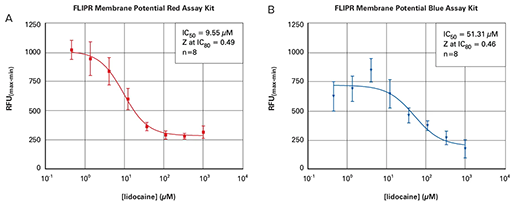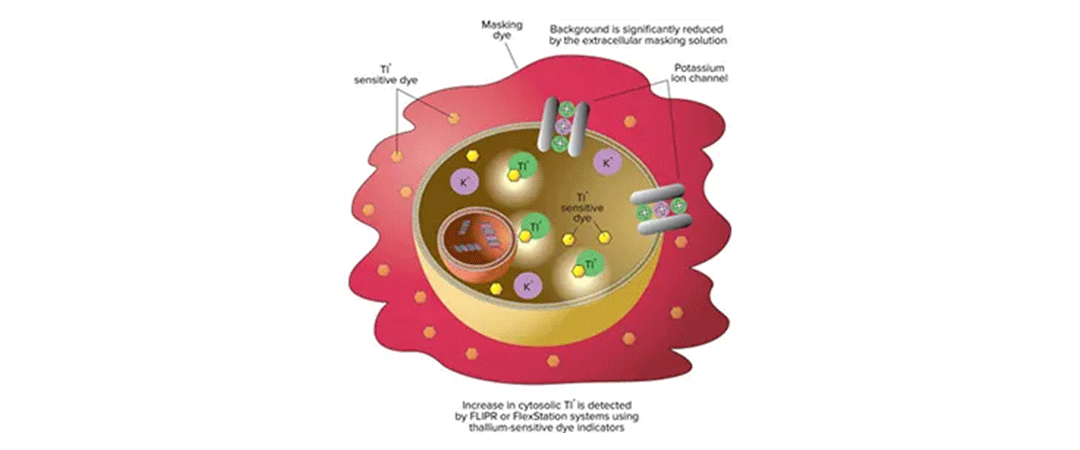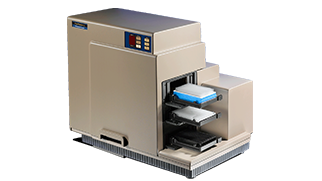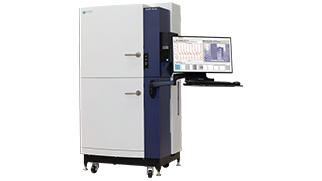FLIPR膜電位測定キット
FLIPR膜電位測定キットとは
FLIPR®膜電位測定キットは、イオンチャネルの活性化やイオン輸送体タンパク質に関連する膜電位変化をリアルタイムで観察するための、ホモジニアス蛍光ベースの製剤を提供します。
FLIPR膜電位測定キット
各ホモジニアスアッセイキットは、特許取得済みインジケーター色素とクエンチャーの組み合わせを利用し、データのばらつきの原因を排除しながら、セルライン/チャンネル/化合物の適用性を最大化します。この独自の配合は、従来の色素よりも10倍速く反応し、温度安定性が高いため、手動のパッチクランプアッセイと良好な相関性を示す高品質のスクリーニングデータを提供します。
イオンチャネルの活性は非常に敏感であり、微妙な化学変化によって影響を受ける可能性があるため、デリケートなイオンチャネルのターゲットに最適な条件を選択するために、2種類のFLIPR®膜電位測定キット(赤と青)が用意されています。どちらの製剤も、TRP、リガンド、環状ヌクレオチド、電位依存性チャネルを含む様々なターゲットをスクリーニングするために、シグナルウィンドウを増強し、許容可能なZスコアを得るためのモレキュラーデバイス特許取得済みクエンチテクノロジーを利用しています。
DiBACのような従来の色素とは異なり、FLIPR膜電位測定キットは双方向の勾配変化を検出するため、1回の実験で可変条件とコントロール条件の両方をモニターすることができます。どちらのアッセイキットがターゲットに適しているかを見極めるために、両方のアッセイキットを評価することをお勧めします。
FLIPR膜電位測定キットのデータ
-

パッチクランプ法とFLIPR膜電位測定キットのデータ比較
手動パッチクランプ法は高速応答を検出できるため、膜電位の非常に速い変化を検出できる。FLIPR膜電位測定キットを用いて作成されたデータと手動パッチクランプ法の結果を比較すると、良好な相関性が示されます(図1および2)。イオンチャネルの開口と閉口の両方が観察できる。これは、膜電位の一方向の変化しか示せないDiBACとは異なる(図3)。
電位依存性K+チャネルを発現するCHO細胞におけるパッチクランプ(mV)とFLIPR膜電位(蛍光)アッセイの比較。
Data courtesy of Michael Xie, Millenium Pharmaceuticals. -

蛍光 vs 膜電位変化
膜電位の変化とFLIPRインストゥルメンテーションの蛍光アッセイとの相関: K+チャネルをトランスフェクションしたCHO細胞を様々な濃度のカリウムに暴露した。
Data courtesy of Michael Xie, Millenium Pharmaceuticals. -

リガンド依存性カルシウムチャネルの比較
FLIPR膜電位測定キット、DiBAC、Fluo-3アッセイによるリガンド依存性Ca2+チャネルの比較。
Data courtesy of Michael Xie, Millenium Pharmaceuticals. -

2種類の膜電位測定キットのクエンチオプション
イオンチャネルの活性は干渉に対して敏感であり、特定のイオンチャネルに対する化学的干渉は非常に予測しにくいため、FLIPR膜電位測定キットには2種類の製剤があります。どちらの製剤も、当社特許取得済みの膜電位インジケーター色素とクエンチ技術を組み合わせたものです。一方の製剤は青色クエンチャーを使用し、もう一方の製剤は赤色クエンチャーを使用しています。どちらの製剤が最適かを判断するために、個々の標的/セルラインごとに両方の製剤を評価されることをお勧めする。
テトロドトキシンによるCHL-hH1細胞のNav1.5チャネルの調節。このアッセイでは、30mMのベラトリジンを用いてナトリウムチャネルを開口状態に保持する。テトロドトキシン濃度が高くなるにつれて調節が起こる。細胞内へのNa+の急激な流入が起こり、続いて膜が偏光解消され、蛍光が増加する。このアッセイでは、Membrane Potential Red Kitの方がシグナルウィンドウが大きく、Zファクターも大きかった。
FLIPR膜電位測定キットの技術
-

細胞膜電位の増減に伴う蛍光強度の変化
FLIPR膜電位測定キットは、細胞膜電位の変化に伴って蛍光シグナルが増減することにより、イオンチャネルの変調を検出します。膜偏光解消時には、色素が細胞内の正電荷を帯びたイオンに追随して蛍光強度が増加する。細胞膜の過分極時には、色素が正電荷を帯びたイオンを追って細胞外に出るため、蛍光シグナル強度は減少する。このキットはFLIPR® システムとFlexStation® 3 マルチモードマイクロプレートリーダーのピペットと測定が同時に行えるので、イオンチャネルの活性化に伴う速いカイネティックを捉えるのに最適です。
このキットは、バックグラウンド蛍光を減少させ、シグナル対SN比を改善するためにクエンチ色素を採用しています。特許取得済みのクエンチ技術(米国特許番号 6,420,183、EPO特許番号0 906 572)は、FLIPR測定キットの購入を通じて、モレキュラーデバイスが創薬研究者およびライフサイエンス研究者に独占的に提供しています。

